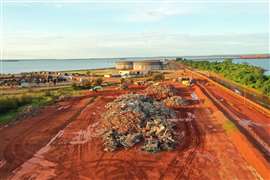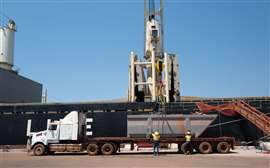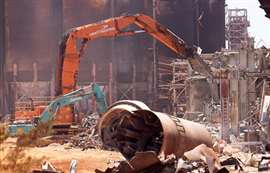VIDEO: Recycling begins on “largest demolition project in Australia’s history”
21 November 2023
Australian metals and mining company Rio Tinto and demolition contractor Liberty Industrial have begun recycling activities at what is claimed to be the “largest demolition project in Australia’s history”.
 Over 142,000 tonnes of scrap steel is expected to be recovered the Gove Refinery site in Australia. (PHOTO: Rio Tinto)
Over 142,000 tonnes of scrap steel is expected to be recovered the Gove Refinery site in Australia. (PHOTO: Rio Tinto)
Dismantling and remediation works underway at Rio Tinto’s Gove Refinery site in the country’s Northern Territory, which processed bauxite into alumina from 1972 to 2014, are expected to produce roughly 142,000 tonnes of scrap steel - the equivalent of three Sydney Harbour bridges or 21 Eiffel Towers.
A year after the works began, a shipment containing the first 15,000 t of scrap metal from the site has now left Gove Wharf and is bound for Asia, where it will be recycled into new steel wire, bar and beam products.
 The first shipment of scrap metal, weighing around 15,000 tonnes, recently left Gove Wharf headed for Asia. (PHOTO: Rio Tinto)
The first shipment of scrap metal, weighing around 15,000 tonnes, recently left Gove Wharf headed for Asia. (PHOTO: Rio Tinto)
Anthony Milanich, Liberty Industrial’s Director for the Gove Refinery project, said: “We are very pleased with how this substantial project has been going, with the first of many scrap load outs successfully completed in better-than-expected time.
“We look forward to continuing our journey with Rio Tinto and Traditional Owners, who we consult and work with closely. This close collaboration has helped us find solutions to a number of challenges associated with a project of this size and complexity in a remote location.”
While a further nine shipments of scrap steel are expected to be delivered to the Asia over the course of the demolition project, which is scheduled to be completed in 2027, the project team is anticipating that around 300,000 tonnes of concrete will also be recovered from the site. This will be recycled for local road construction and other projects.
 Demolition and remediation works are scheduled to be completed in 2027. (PHOTO: Rio Tinto)
Demolition and remediation works are scheduled to be completed in 2027. (PHOTO: Rio Tinto)
According to Rio Tinto, the current demolition and remediation works is part of a broader closure programme for Rio Tinto’s Gove Operations in East Arnhem Land, where bauxite mining is expected to cease later this decade.
The metals and mining specialist is planning to completely rehabilitate the site of the refinery, mine and tailings facilities, before the land is returned to be managed as Aboriginal land.
James Low, Rio Tinto Gove Closure General Manager, said: “This iconic site holds a lot of memories for the thousands of people who worked here over the last five decades. But even more significant is the immemorial connection that the Gumatj Traditional Owners have with the land. We are excited to be part of the work that returns the site to them.
“The Gumatj are integral to what we are doing at the refinery. They are the key decision-makers for how the site will be left in the future, including whether infrastructure like the wharfs and warehouses will be handed over for ongoing use. Their business arm is also supplying equipment for the demolition.”
STAY CONNECTED


Receive the information you need when you need it through our world-leading magazines, newsletters and daily briefings.




